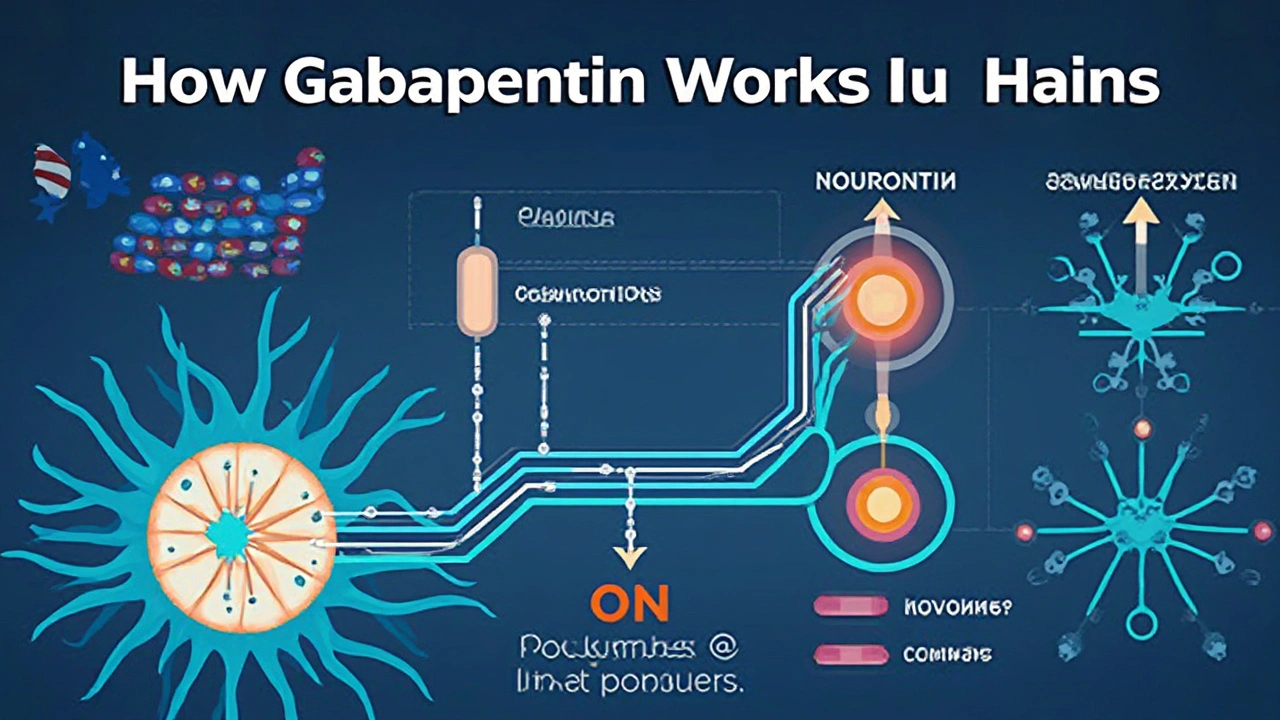Word on the street is you either love Neurontin or you dread it—and rarely does anyone sit on the fence. Neurologists hand it out for everything from stubborn nerve pain to anxiety, yet most folks know it by whispers from friends or a label on three months’ worth of orange bottles in the kitchen cabinet. Here’s what’s often left unsaid: Neurontin’s story is filled with twists, rapid popularity, and side effects people sometimes only discover after they start taking it. Those little white capsules have changed lives, and sometimes, not quite in the way people expected.
What Is Neurontin and How Does It Work?
Back when Neurontin (the brand name for gabapentin) first got approved in 1993, nobody quite knew it would explode into so many medicine cabinets. Originally, the drug was meant to help people with seizures, but it’s now mostly used for nerve pain—a condition that can make even the smallest touch feel like electric shocks. At its core, gabapentin works by adjusting how nerves send signals in your body. Think of it as a bouncer at a rowdy club: when nerves try to kick off a wild party (aka send too many pain signals), Neurontin steps in and calms things down.
Strangely enough, gabapentin isn’t related to common painkillers like acetaminophen or ibuprofen, and it has nothing to do with opioids either. It was created to mimic the effects of gamma-Aminobutyric acid (GABA), a chemical that chills out signals in your brain, yet it doesn’t act directly on GABA receptors. That’s part of why researchers are still, even now, trying to figure out all the tricks Neurontin gets up to in the nervous system.
If you check the data, the prescription rates for gabapentin have gone up more than 60% in the last decade. Docs prescribe it for conditions like diabetic neuropathy, shingles pain, fibromyalgia, and in some cases, restless legs syndrome. Oddly, it’s even used off-label for anxiety and insomnia, though that use is less well-supported by evidence.
So, who’s taking Neurontin? If you peek into the stats, it’s mostly adults over 40 with chronic pain, but the range is getting broader every year. Even my aunt June, who once swore she’d never touch anything stronger than Tylenol, now swears by her little blue Neurontin pills for nerve pain from shingles. And she’s not alone—millions fill those prescriptions every year.
Here’s a neat table showing some of the main conditions Neurontin treats and how effective it is, based on clinical studies:
| Condition | % Reporting Relief | Average Dose (mg/day) |
|---|---|---|
| Postherpetic Neuralgia (Shingles pain) | 30-50% | 1,800-3,600 |
| Diabetic Neuropathy | 35-45% | 900-3,600 |
| Partial Seizures (as add-on therapy) | Up to 50% | 900-1,800 |
| Anxiety Disorders (off-label) | 20-35% | 300-2,400 |
Gabapentin is not a magic bullet, but for stubborn nerve pain, it can be a game-changer.
Common Uses for Neurontin in Daily Life
Ask three people why they take Neurontin, and you’ll get three completely different answers. For some, pain from nerve damage after cancer surgery never really goes away, but gabapentin takes the edge off. Others have migraines so bad they miss work for days, and gabapentin is what lets them power through. My friend Lisa uses it when her fibromyalgia flares up, and says she’d rather be groggy than stuck in constant pain. The flexibility is part of why Neurontin is on so many shelves.
Nerve pain is easily the top use. It hits after injuries, diabetes, shingles—any condition where nerves go haywire. When something gnaws at your feet day and night (think diabetic neuropathy), Neurontin is often the first thing neurologists turn to that isn’t a narcotic. It takes a bit of patience, though: relief doesn’t come overnight. Doses start small (like 100-300mg), then docs slowly ramp them up to avoid heavy side effects. Sometimes it takes a few weeks before you notice a difference.
Doctors sometimes hand out Neurontin for seizures, usually together with other anti-epileptic meds. It doesn’t stop a seizure the moment it hits, but it helps keep them from showing up in the first place. For patients with epilepsy who can’t control seizures with older drugs, Neurontin gives another option without many of the risks linked with older medications.
It gets even more interesting with off-label uses. There’s some real-world support for using Neurontin to calm restless legs at night, reduce anxiety symptoms, and even help people quit alcohol. In a real sense, it’s a Swiss Army knife in neuro medicine. It isn’t always a cure, but sometimes just getting a break from pain or anxiety is enough to turn someone’s week around.
Here are a few tips I’d share, straight from both the research and family experience:
- Take it as prescribed. Missing doses makes it less effective and quitting suddenly can make you feel sick.
- Give it time. The first days are often foggy or drowsy, but many people adjust within a couple of weeks.
- If you work late shifts or need to drive a lot (like me, juggling daycare drop-offs for Dorian), talk to your doctor. Grogginess is common at first—but sometimes the schedule can be adjusted to minimize that.
- Don’t mix with alcohol or sedatives unless your doctor okays it. The combo can knock you out or make you dizzy enough to fall.
- Let family know about the medication. This way, if you act off, they know what’s going on.
Real people rely on Neurontin simply to get through the daily grind. The stories aren’t flashy, but they’re the backbone of how the drug keeps showing up on pharmacy top-10 lists.

Neurontin Side Effects You Should Watch For
No drug is perfect, and Neurontin is no exception. Most people notice drowsiness during the first week or two. That heavy eyelid feeling? Totally normal, especially if your dose increases quickly. Dizziness, shaky hands, and a feeling of mental slowness can show up, too—but again, for many, this fades after your body adjusts.
My buddy Mike once called me convinced he was coming down with the flu—turned out, it was just Neurontin, plus cold weather and not enough sleep. He felt lightheaded, a bit spacey, and had trouble focusing on little things. These symptoms freak a lot of people out but, if you stick with your prescribed dose and mention new problems to your doc, most side effects are manageable. Here’s a simple breakdown of the most common ones and how often they happen:
| Side Effect | How Common? |
|---|---|
| Drowsiness | 30-40% |
| Dizziness | 28-35% |
| Unsteady Walking | 10-15% |
| Blurry Vision | Up to 8% |
| Tremor | Up to 6% |
| Weight Gain | 5-10% |
| Swelling in hands/feet | Up to 8% |
Most of these won’t land you in the ER, but there are a few warning signs that shouldn’t be ignored—swelling in your face, rash, trouble breathing, mood changes like depression or suicidal thoughts. For kids (and yes, gabapentin does get prescribed to young people sometimes), behavior changes or hyperactivity can pop up. It’s smart to keep an eye on how moods and physical symptoms shift over time.
A less common, but important, side effect is withdrawal symptoms if you stop Neurontin suddenly. Folks can get anxious, sweaty, or even have seizures. The rule is: don’t quit cold turkey. Always step down gradually with your doctor’s help.
Managing side effects takes some trial and error. For example, Iris noticed more swelling in her ankles a month in, so the doc tweaked her dose and it helped a ton. Little adjustments, a chat with the prescriber, or just timing your dose for bedtime—all can make a world of difference. If life suddenly feels a little too “off,” reach out for advice instead of toughing it out.
Neurontin: Myths, Misunderstandings, and Everyday Realities
People hear “Neurontin” and a thousand different rumors spark up. Is it addictive? Does it always cause brain fog? Do people really take it for back pain, or are doctors just guessing? Here’s the lay of the land, myth by myth.
First, is Neurontin habit-forming? Not like traditional painkillers, but, rarely, some people start misusing it—mainly if they mix it with other substances or have a prior history of substance use disorder. Doctors keep an eye out but for most regular folks, taking the right dose as prescribed, there’s no wild rush or urge to take more. Think of it the way you do with blood pressure meds or cholesterol pills—it’s just part of your routine.
Brain fog, though, is real for some, especially starting out. Iris used to joke that she had "Neurontin head" the first few mornings after her prescription changed. Focusing on work might get weird while your body settles in, but most report things clear up or become manageable with time. If your job involves quick reactions, talk this through with your doctor.
Another hot topic: off-label use. Docs prescribe *Neurontin* for loads of things that aren’t officially approved—anxiety, migraine, restless legs—because they see it work in practice, even if drug companies haven’t spent years proving it. Data doesn’t always match the day-to-day reality, and research is slowly catching up to how people actually use the drug.
Let’s clear up the back pain debate, too. Neurontin only really helps with back pain if there’s a nerve component—like sciatica or nerve damage. Ordinary muscle aches? Not so much. If you take Neurontin for non-nerve pain and aren’t feeling better, circle back to your healthcare provider because there may be a more targeted treatment.
Some believe that once you start Neurontin, you’re stuck forever. That’s not true. If pain improves or better treatments come along, most doctors are happy to help you taper off slowly. Just don’t try to do it yourself over a weekend—rushing the process is the fastest way to end up feeling worse.
Finally, people wonder about driving or parenting on Neurontin. Most adjust fine, but the first few weeks may throw you for a loop. With my kid Dorian in tow, I made sure I had backup during school pickups while adjusting to the medication—foggy brains and busy crosswalks don’t mix. If something doesn’t feel right, phone a friend or postpone demanding tasks until you steady out.

Tips for Safe and Effective Neurontin Use
You want to feel better, not more frustrated—so, a few real-world strategies make all the difference with Neurontin. Step one: communication. Before you leave with your first prescription, ask your doctor how to watch for side effects and report any odd symptoms quickly. The people who do best with Neurontin are usually those who stay in regular touch with their healthcare team.
If memory isn’t your strongest suit, set phone reminders for doses—especially those mid-day ones that sneak up while you’re busy. Many people keep a "medicine journal" or use an app to track how they feel at different times and doses. The more details you collect, the easier it is for you and your doc to fine-tune the plan.
Here are a few tips I wish more people heard before starting Neurontin:
- Take it with food if you get an upset stomach.
- Keep water nearby. Dry mouth can be sneaky and sometimes annoying.
- Steady routines help: same times, same activities, etc. Your body learns to expect the med, and side effects tend to settle faster.
- Watch for changes in mood or mental state. Depression and anxiety can sneak up—and they’re important to catch early.
- Don’t share your pills with family, even if they have "the same pain." Meds hit everybody’s system differently.
- Travelers, double-check carry-on rules and keep a current prescription note handy, especially when flying. Customs agents and TSA sometimes question unfamiliar prescription bottles.
- Take extra care with other meds. Some medicines, like magnesium antacids, can mess with gabapentin absorption—best to space them out by a couple hours if possible.
- neurontin should not be quit cold turkey. Always work with your prescriber to taper down slowly.
One last thing: talk is cheap, but patient support counts. Whether it’s an online message board, a caregiving spouse, or even a straightforward pharmacist, building your "med squad" can make rough days a little smoother. If you’re struggling with remembering pills, tracking side effects, or dealing with skepticism from relatives, you’re definitely not alone. Support helps people stick with a plan and get the most benefit out of every dose.
With nerve pain and chronic conditions, there’s no shame in needing help—or in giving yourself a learning curve to get used to a new medication. Make the system work for you and you’ll get the best shot at relief without extra stress. That orange bottle might not fix everything, but with the right info, you can make it work for you and keep living the life you want.

